Shark behavior and tips on how to behave when you find yourself in the water with a shark
A while back we did a dive trip to Tofo, Mozambique. On our 4th dive of the trip, we were just about to end our dive on a dive site named Sherwood Forest when a Great White shark came to greet us. We were absolutely awe-struck coming face to face with this magnificent animal. She was very inquisitive and not skittish at all and circled us as we slowly started making our way to our safety stop. She kept moving just out of sight and then coming closer again while circling us. The visibility was not great that day. We did not feel threatened at all as the shark seemed calm and not overly inquisitive.
We fear what we do not understand.
I must say, I always thought I would be scared coming face to face with a White Shark, but I felt a feeling of excited amazement and great respect. She eventually disappeared by the time we were doing our 3min safety stop at 5m.

Some of the happy divers that were on this dive.
From left to right: Marius, Mari and Madelein
We had a chat with Great White expert Dr Sara Andreotti, a marine biologist in the Department of Botany and Zoology at Stellenbosch University to find out more about these amazing sharks.
Where can Great Whites usually be found?
White sharks are usually found in temperate and cold-temperate coastal waters all around the world. In South Africa, they seasonally utilize inshore areas when following their prey and then move to seal island during the winter season, which has been evident in areas such as False Bay and Gansbaai. It is believed that it has mostly to do with the availability of prey in the different areas in the different seasons.
Tell us more about White Shark Research and Identification
White sharks can be identified by taking high-quality photos of their dorsal fins, in fact, white sharks have some notches on the dorsal fin that acts like a fingerprint and allows researchers to identify the individuals permanently. By doing that you can count how many sharks are in a population without double-counting the same animals. When photo identifications are collected over several years, they also allow for estimating how many sharks are in a population.
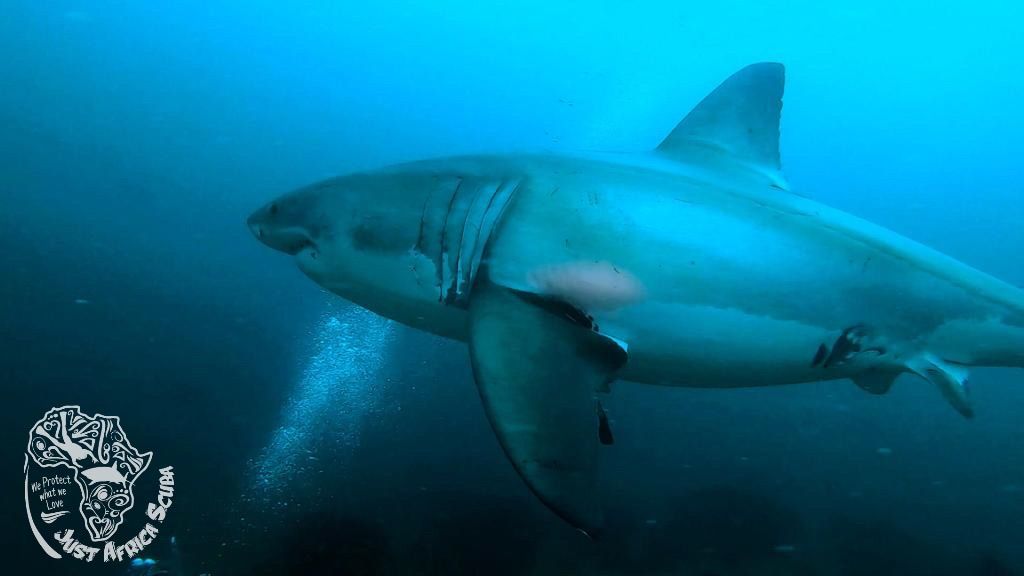
Screengrab of the Great White shark encountered on the dive in Tofo on 25 Nov 2019.
Researching white sharks’ numbers by collecting high-quality photo identification data is extremely important because it doesn’t just give an insight into the population number but also, over time, shows whether a population is getting bigger or smaller.
We sent a screengrab of the individual we encountered in Tofo for identification with Dr Sara Andreotti and Mary Rowlinson. Unfortunately, the photo quality was not quite good enough for a definitive answer, but they did find a close match.
The most similar shark they found in the database was a female that was photographed for the first time on the 14 of March 2010 which also had the top front shape of the dorsal fin a bit flat. She was 3.2m when they last saw her.
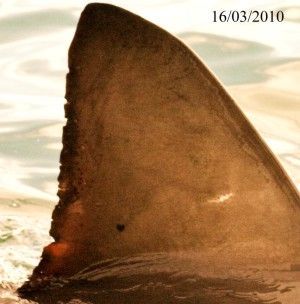

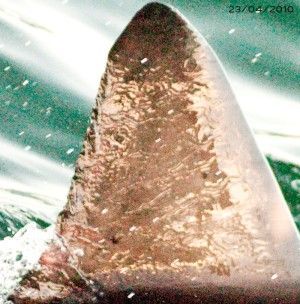
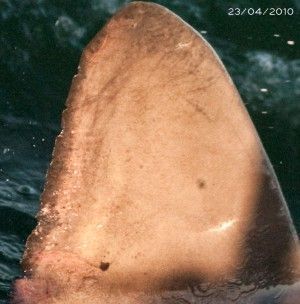
Dorsal fin pictures used in the identification of the individual we encountered.
(Thanks to Dr Sara Andreotti)
Let’s talk about Shark Behavior – What can a diver look for when encountering a white shark?
In contrast to other sharks, white sharks don’t tend to close their pectoral fins when they are upset about something. They normally close down the pectoral fins when they have to make sharp turns. Another display of aggression has been evident in white sharks, which is the opening and closing of their mouth. It is called gaping behavior and they only do that if they are not happy with a situation. If the shark is comfortable with a situation they would just swim around, they will observe and swim away.
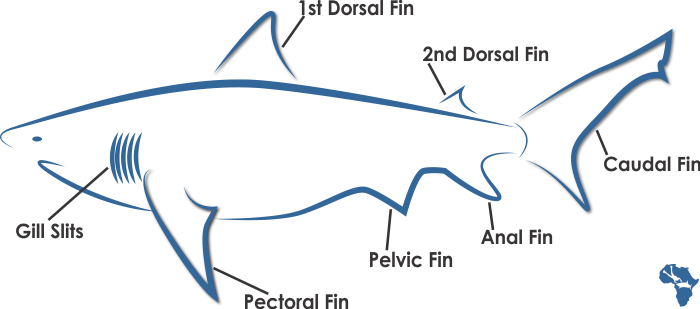
Tips on how to behave when you find yourself in the water with a white shark
If you find yourself in the water in the presence of a large shark the best thing to do is to stand still. They are predators and similar to dogs, when something moves away from them, their instinct is to chase and immobilize the animal that is running away. Because only prey runs away from predators. The best tip I can give is, when in the presence of a shark, just stay still and keep your eyes on the shark at all times. Also, remember not to chase after a shark. The animals read your body language and if you start swimming towards the animal, maybe because you want to take a close picture, it could be perceived by the shark as a sign of aggression on your side.
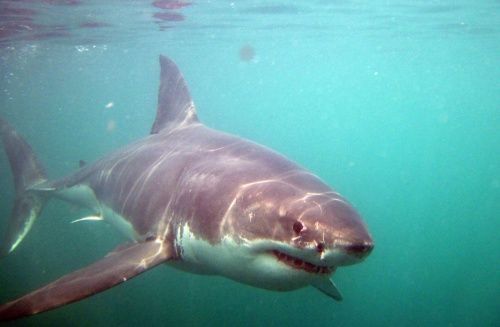
Great white shark underwater. Picture by Dr Sara Andreotti
Just remember that sharks don’t know what we are underwater, and the way we move our bodies is going to inform them of what we are. Whether we are competitors or prey, it is up to us to tell them what we are. The best to do is to communicate that you are not a threat, so don’t start chasing the shark around because you have a camera in your hands. Tell the shark that you are not prey, so stand your ground if the animal comes closer. Wait until the animal starts moving away from you, then only start to slowly swim back to the boat or shore.
Dr Sara Andreotti is a marine biologist, and a postdoctoral researcher at the University of Stellenbosch, working toward the development of a global long-term management system and conservation plan for great white sharks. More info on their website www.sharksafesolution.com
Education and awareness play a vital part in protecting sharks
Here is a short list of tips for encounters with any shark:
- Maintain your position – let the shark approach you.
- Avoid waving your hands around keep them still and close to your body.
- Be aware of where the shark is – look around.
- Do not try and touch the shark.
- Don’t swim after the shark.
- If you feel threatened because the shark comes too close for comfort, breathe out, the loud release of bubbles from your regulator should deter the shark.
- Make yourself bigger — if you feel threatened or the shark is coming too close for comfort join hands with your dive buddy and stay close together. In this way, the two of you seem like one big animal and will also keep the shark at bay.
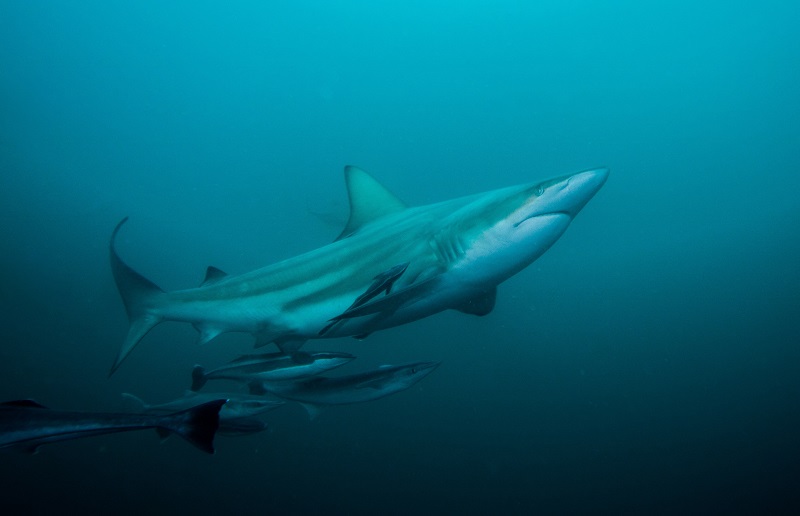
Oceanic blacktip shark by Madelein Wolfaardt
Most divers truly enjoy seeing sharks on a dive and hope for and even pay for such encounters. Sharks and especially white sharks’ bad reputation in the media is very slowly changing, and we hope that your reading of our peaceful encounter with this apex predator will help spread the word. We fear what we do not understand. As divers and ocean enthusiasts alike, we need to educate ourselves and others about sharks.
Contact us for dates for our next Trip.
Read more about being Shark Smart: A Comprehensive Guide to Safe Coexistence with Marine Predators
We Protect What We Love, Join the Movement!

by Madelein Wolfaardt
Some images by @sealife_madeleinwolf
www.madeleinwolf.co.za



